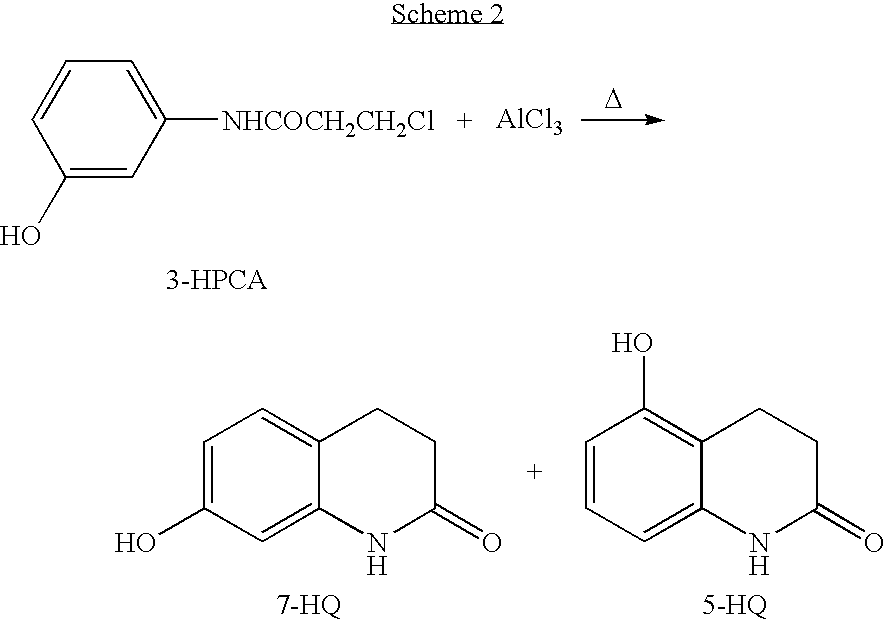Processes for preparing 7-hydroxy-3,4-dihydro-2(1H)-quinolinone and the use in aripiprazole preparation thereof
a technology of quinolinone and process, which is applied in the field of improved, can solve the problems of difficult decomposition difficulty in achieving 80% of pure colorless 7-hq reported for shigematsu's method, and difficulty in reducing the yield of complexes by traditional methods, etc., and achieves the effect of improving the mixing ability of large-scale preparations and improving the stirring of reaction mixtures
- Summary
- Abstract
- Description
- Claims
- Application Information
AI Technical Summary
Benefits of technology
Problems solved by technology
Method used
Image
Examples
example 1
Preparation of 7-HQ in a Mixture Containing a High Boiling Solvent
[0086] A 3.0 l reactor was charged with 3-MPCA (300 g, 1.4 mole), AlCl3 (920 g, 7.0 mole, 5 eq.) and N,N-dimethylacetamide (65 ml, 61 g, 0.5 eq.) and the reaction mixture was heated under stirring to about 160° C. to obtain a readily stirred liquid. The reaction mixture was held at 155-165° C. for about four hours under stirring, then cooled to about 50° C. Cold water (1500 ml) was added for a time period of half an hour and the mixture was stirred under heating to about 95° C. for one hour. The suspension thus obtained was cooled to about 50° C. and a red-violet solid was collected by filtration, washed with water (400 ml) and dried in an oven at 50° C. overnight to yield a red-violet complex of 7-HQ with AlCl3 (202 g), containing about 2% of 5-HQ.
[0087] The complex (202 g) was dissolved in methanol (1600 ml) while heating under reflux and 47% aqueous sodium hydroxide solution was added to produce a pH of about 7. ...
example 2
Preparation of 7-HQ in the Presence of a Salt
[0089] A 0.5 l reactor was charged with 3-MPCA (40 g, 0.185 mole), AlCl3 (125 g, 0.925 mole, 5 eq.) and anhydrous sodium chloride (20 g) and the reaction mixture was heated under stirring to about 160° C. to obtain a readily stirred slurry. The reaction mixture was held at 155-165° C. for four hours. The reaction mixture was cooled to about 50° C. and quenched by slowly adding ice cold diluted hydrochloric acid (200 ml of 5% HCl) to the reactor. The suspension thus obtained was heated to 50° C. and a red-violet solid was collected by filtration. The red-violet solid was slurried at 50° C. in water (100 ml) to remove the salts from the compound, and the solid was collected by filtration, washed with water (30 ml) and dried in an oven at 50° C. overnight to yield a red-violet complex of 7-HQ with AlCl3 (27.1 g), containing about 2% of 5-HQ.
[0090] The complex (27.1 g) was dissolved in methanol (220 ml) while heating under reflux and 47% aq...
example 3
Preparation of 7-HQ in a Melt
[0091] A 2.0 l reactor was charged with 3-MPCA (150 g, 0.69 mole) and AlCl3 (460 g, 3.45 mole, 5 eq.).The reaction mixture was heated under stirring to about 160° C. to obtain a liquid. The reaction mixture was stirred and held at 155-165° C. for about four hours. Stirring was stopped and the reaction mixture was cooled to 50° C. Ice cold diluted hydrochloric acid (750 ml of 5% HCl) was added to the reactor during half an hour and the mixture was stirred while heating to about 95° C. for one hour. The suspension thus obtained was cooled to about 50° C. and a red-violet solid was collected by filtration, washed with water (200 ml) and dried in an oven at 50° C. overnight to yield the red-violet complex of 7-HQ with AlCl3 (100 g), containing about 2% of 5-HQ.
[0092] The complex (100 g) was dissolved in methanol (800 ml) while heating under reflux and 47% aqueous sodium hydroxide solution was added to produce a pH of about 7. The hot solution was filtered ...
PUM
 Login to View More
Login to View More Abstract
Description
Claims
Application Information
 Login to View More
Login to View More - R&D
- Intellectual Property
- Life Sciences
- Materials
- Tech Scout
- Unparalleled Data Quality
- Higher Quality Content
- 60% Fewer Hallucinations
Browse by: Latest US Patents, China's latest patents, Technical Efficacy Thesaurus, Application Domain, Technology Topic, Popular Technical Reports.
© 2025 PatSnap. All rights reserved.Legal|Privacy policy|Modern Slavery Act Transparency Statement|Sitemap|About US| Contact US: help@patsnap.com



